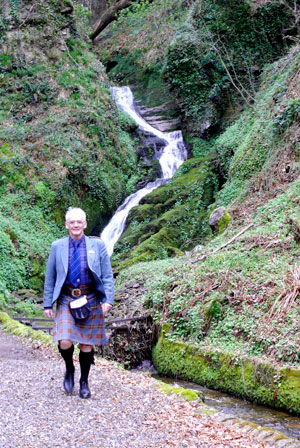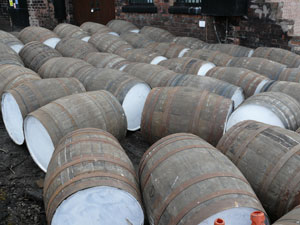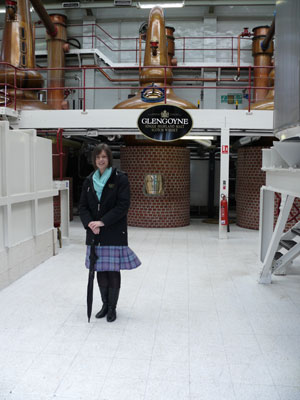EDINBURGH - To come to Scotland and not sample the whisky is like going to England and not having tea. Even a non whisky drinker like myself cannot leave this land of kilts and haggis without tasting what the Scots call the “water of life.”
So, at the invitation of a couple of Scots named Allan and Ken, I’m being led up a winding staircase in what once was a handsome Georgian home in a fashionable area of this most lovely of national capitals and into a room where a group of people have their noses buried deep in glasses.
Oohs and awes fill the room as the noses emerge from the glasses, which are then held to the light, revealing the mahogany-colored liquid that is to Scotland what Champagne is to France and wine is to Italy. The European Union has even decried that no whisky can be called “Scotch” unless it has been bottled in Scotland.

Above: Scots take their whiskey tradition seriously.
“We’ll make a Scotch lover out of you by evening’s end,” the kilted Kenny promises as he introduces me to some other members of the Scotch Malt Whisky Society, a drinking clan formed to protect the sanctity of Scotch whiskey.
Part of their sacred oath, I think to myself, must be to sample the finest whiskies made in the Highlands, Lowlands, islands and other parts of Scotland and discounted prices.
These thrifty Scots will form any society to get cheap booze, I think to myself.
But, I quickly learn, the members of the SMWS take their responsibilities to Scotland’s national brew seriously and can tell with one sniff where the whiskey originated.
“Like wine, whisky must first be sampled with the nose,” Kenny tells me as the barmaid delivers several bottles of unmarked Scotch to our table.
Whisky delivered to the society is never branded and is only identified by a cask number written on a generic label. Our bottles come with the cask numbers 1.136, 9.42 and 30.53.
After putting their noses to the specially designed whisky glasses, Allan and Kenny hold the contents to the light, swirl the golden liquid around and then sip it gently through their lips.
A moment of anticipation follows before Kenny identifies the first sample (cask 1.136) as being from the “valley of the green grass” near Marypark in Speyside, one of the five main regions where whisky is made.

Above: Scotch whiskey production remains a huge export.
After a few seconds, Allan agrees and I’m offered my first sample.
“Here’s a splash of water,” Kenny says. “It will help soften the taste of the whisky on your tongue.”
I raise the glass to my lips and the smell of old polished furniture jumps into my nose and produces a pained look on my face.
“All I can smell is furniture polish,” I tell the group.
“Yes,” says Kenny gleefully. “And you should also be getting scents of cherries, dried fruit, nuts, orange, dark chocolate, gingerbread and toffee.”
“There should also be hints of dried pineapple and papaya,” chimes in Allan who describes our first sampling as being “majestic and refined.”
The sample from cask No. 9.42 is deemed to be “fragrant and relaxing” by my two whisky connoisseurs and the last bottle from cask No. 30.53 is “fresh and perfumed,” according to Ken.
“Even though the bottles are not marked with the name of the distillery, we can pretty much tell by the taste where the bottles come from,” says Ken with a twinkle in his eye. “One of the ones you tasted is actually an 18 year old scotch.”
The evening is filled with lots of facts on whisky history, including a tidbit about how the brew was used as currency in the time of legendary Rob Roy, and how it must remain in the cask for at least three years before it can be called Scotch whisky. Kenny, the Scotch historian of the clan, tells me Lowland whisky is generally light in color and weight and typically has a dry finish. The Highlands, where most of Scotland’s national drink comes from, produces many variations, from dry to medium bodied. Greater Speyside is where malt whisky has been perfected over the centuries but three distilleries in Campbeltown, on the country’s west coast where once 30 distilleries thrived, produce very distinctive single malts.

Above: Tours of whiskey plants a big tourist draw.
On the tiny island of Islay, where there’s the highest concentration of distilleries in the world, they produce malts that pack a punch to the nose thanks to the pungent peat used to dry the barley during production.
By the end of the evening, I had a new-found appreciation for whisky, not to mention a glow that comes from sampling too much, and left the Scotch Malt Whisky Society a full-fledged foreign member. But that wasn’t the last of my whisky tasting experience.
“No one comes to Scotland without visiting a distillery,” says Kenny firmly as he pulls into the entrance of the famed Glengoyne distillery on the edge of Scotland’s Highlands a few days later.
A whimsical setting - lush forest and a lovely mountain waterfall – greets us and soon a bonnie lass named Lauren Wylie tells us how whisky was first brought to Scotland by monks and how the brew gets its color from the oak and cherry casks it lies in.
“The casks used in aging whisky are actually used first by sherry producers for three years, who by law, can only use a cask once and then they sell them to us. The color of whisky is determined by how long it lies in the cask,” says the charming Lauren.
Glengoyne began producing Scotch whisky in 1833, back when a license cost about $20. Today, a dram of high-quality Scotch costs that much.
Lauren also tells us what makes malt whisky different from the blended variety.
“Malts are produced from one distillery while blends, as the name suggests, are a combination of several distilleries,” she reveals.
The waterfall at the back of the distillery plays an important role in the production of whisky, since, Lauren tells us, 100 litres of clean spring water is needed to produce one bottle of whisky.
What makes whisky so expensive is that during the aging process, 2 per cent of the cask contents evaporates into the air each year. So, a 10-year-old cask will lose 20 per cent of its contents and a 30 year old, well, you do the math. The part that disappears into the air and blackens surrounding buildings in the process, is called the “angels share,” laughs Lauren. The casks usually have a 60-year lifespan and cost about $1,000 each for the 500 litre variety.
“Nothing is wasted in the production of Scotch whisky,” says Lauren with the laughing eyes. “After the sugar has been extracted from the barley, the waste is fed to livestock – and we make lots of cows happy.”
A sweet smell greets us as we enter Glengoyne’s fermentation room where yeast is added to the product to make a sugary liquid. The whisky is actually clear in color before it enters a cask.
Huge copper stills used in the production process start out 8mm thick and over their 20-year lifespan are reduced to just 1mm in thickness. That means some copper settles in the Scotch but Lauren assures us “you would have to drink 20 bottles of whisky a week before you would die of copper poisoning.”
Hey, what a way to go!
Another thing that makes Scotch whisky so expensive is that each bottle is taxed about $16 before it leaves the distillery. Glengoyne offers tastings and gives visitors a chance to blend their own whisky that you can take home under the watchful eyes of expert guides like Lauren.
Back in Edinburgh, Kenny insists that we also stop off at the Scotch Whisky Experience, located on the Royal Mile where, in the elegant Amber restaurant, dishes prepared with Scotch whisky (don’t hesitate to try the fillet of pork with the whisky and apple chutney) are served up. Afterwards, drams of Scotch can be sampled at the restaurant’s quaint bar. After a few Scotch whisky stops, I quickly realize why every visitor feels intoxicated by Scotland.